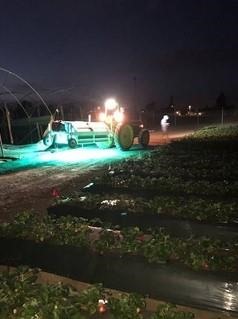By Mark Bolda
A growing body of research out of Cornell University is showing that low doses of UV light can be quite effective against powdery mildews in agriculture, including Podosphaera aphanis, which challenges strawberry growers every year. The dose, delivered by a special UV emitting lamps mounted on a tractor pulled wagon, is enough to kill the mildew but does not harm the plant. As a non-chemical alternative to fungal management, this certainly is an attractive candidate for research.
This project was a collaboration with Dr. David Gadoury from Cornell University, Plant Sciences, Inc. and UC Cooperative Extension.
A pdf of the presentation put together by Clare Taylor from Plant Sciences, Inc. is linked as an attachment below, and I also give a short review of the study highlights here:
The UV light treatment is effective on mildew: This trial is of the efficacy compared to a course of standard fungicides of a UV light apparatus for efficacy on powdery mildew in strawberry and incidentally spider mites. The test was done on four UC strawberry varieties (Monterey, Victor, Fronteras and San Andreas), the untreated control was a proprietary variety which is not included here. This untreated check confirmed that powdery mildew pressure was quite high, with severity (% of leaf coverage) ranging 30%, and incidence (# of leaves affected) at 100 % from May 8 onwards.
The UV light was very effective in managing the mildew, over a total of 45 applications, done twice a week after dusk, the results were equivalent to the grower standard fungicide course. It was observed too that these plants appeared healthier than those treated with fungicides, likely because they were spared the deleterious effect of pesticide use.
The UV light treatment does not result in declines in fruit yield: To understand whether or not the regular use of UV light affects fruit production, yields in all four of the UC varieties were collected twice weekly through the course of the study from mid March through mid August.
Differences between the plots treated with fungicides and those treated with UV light were not found.
No effect has been found by the UV light treatment on spider mites: Spider mites were evaluated along with mildew for susceptibility to UV light.
No effect whatsoever was found on populations of Lewis mites, twospotted spider mites or P. persimilis predatory mites. This work was replicated this past spring (more detailed report to come later), again, the UV light had no efficacy on populations of spider mites.
Pay attention to safety requirements of this UV light treatment: Growers and pest managers should take close note of the SAFETY requirements when working with this UV light apparatus. It is VERY intense, and skin and eyes exposed to it without covering or shielding will be damaged. Please review these prior to engaging in this work - the last slide has a picture of Dr. David Gadoury in recommended gear.
Great, great work by the people at Plant Sciences, Inc. in collaboration with Santa Cruz County UC Cooperation Extension.
Attached Files
September 2020 Summary UV treatment UC varieties only (1)

Source : ucanr.edu